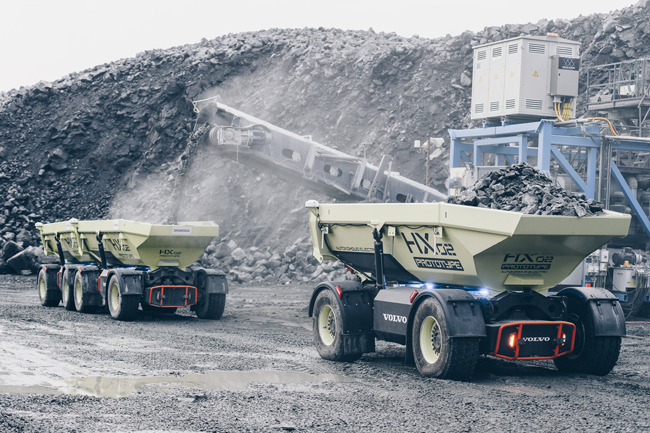
Partners Volvo CE and Skanska say the initial pilot of the Vikan Kross Electric Quarry has shown its huge potential environmental, efficiency, safety and cost benefits. Liam McLoughlin reports.
Volvo Construction Equipment and its customer
The duo tested the viability of the Electric Site research project in a 10-week trial at Skanska’s Vikan Kross quarry, near Gothenburg, Sweden, from September to November last year. The tests are said to have shown a 98% reduction in carbon emissions, a 70% reduction in energy cost and a 40% reduction in operator cost. The quarry is the second biggest in Sweden.
“Over the last ten weeks, we’ve made incredible progress, learnt a lot and seen huge potential in the Electric Site solution’s environmental, efficiency, safety and cost benefits,” said Uwe Müller, chief project manager for the Electric Site at Volvo CE, after the initial phase of the trial completed in November. He added that the trial was being extended until the end of 2018 to carry out more tests.
“The results we have seen so far confirm that this research project is a step towards transforming the quarry and aggregates industry and creating emission-free quarries,” said Müller.
The Electric Site project aims to electrify each transport stage in a quarry – from excavation to primary crushing, and transport to secondary crushing. It incorporates electric and autonomous prototype Volvo CE machines, new work methods, and site management systems, which together form a complete site solution. New technology encompasses machine and fleet control systems and logistic solutions for electric machines in quarries.
The Electric Site project involves eight HX-02 autonomous, battery-electric load carriers which transport the material from the primary mobile crusher up to the secondary static crusher. When it came to energy use per tonne, the HX-02s proved that they could help Volvo CE take a big step towards achieving its future vision where work sites are ten times more efficient. The second-generation prototypes incorporate shared technologies and components from the Volvo Group. They use a lithium ion battery to power two electric motors which drive the machine; the hydraulics are driven by an additional electric motor. The HX2 is fitted with a vision system which allows it to detect humans and obstacles in its vicinity. It can follow an adjustable, preprogrammed GPS path.
The LX1 prototype electric hybrid wheeled loader was claimed to deliver more than a 50% improvement in fuel efficiency at the quarry, as well as significant reductions in emissions and noise pollution, compared to its conventional counterparts. Its job was to organise the piles of material at the site. The LX1 is a series hybrid that incorporates a driveline that consists of electric drive motors mounted at the wheels, electric-driven hydraulics, an energy storage system, a significantly smaller diesel engine and new machine architecture, including a new design of the lifting unit. It’s this combination that enables the substantial gain in fuel efficiency.
The EX1 70-tonne, dual-powered, cable-connected excavator prototype loaded the primary crusher at the quarry. The base machine for the EX1 is a Volvo EC750 crawler excavator that has been upgraded to incorporate an electric motor in addition to the diesel engine. At the quarry, the machine was plugged into the grid, so zero emissions were emitted. If the cable is connected, the EX1 will automatically start in electric mode. If it’s not, it will start in diesel mode. The EX1 is operated in exactly the same way as a conventional Volvo excavator.
“With this research project we are combining intelligent machines, automation and electromobility to challenge traditional ways of working in the quarrying industry and explore new alternatives,” said Melker Jernberg, president of Volvo CE.
At an open day held at the Vikan Kross quarry in November, Jernberg was asked when the technology could actually become available to quarry operators as an “off-the-shelf” solution.
“This is the big challenge,” Jernberg responded. “I think the confidence now in our organisation is to do it much quicker than we thought ten weeks ago. You won’t be able to buy it tomorrow, but it will be quite soon.”
In terms of aims in trial’s the second phase, Skanska Industrial Solutions head of Nordics Gustaf Werner said: “We met targets on CO2 emissions, but we also need to see the productivity levels.”
Per-Erik Lindstrom, VP global key accounts at Volvo CE, said the second stage would push the boundaries of the technology to test its resilience and toughness. “We are really on the front line with system complexity such as wi-fi,” he added. “We need to improve the reliability of the technology as we are not quite there yet.”














